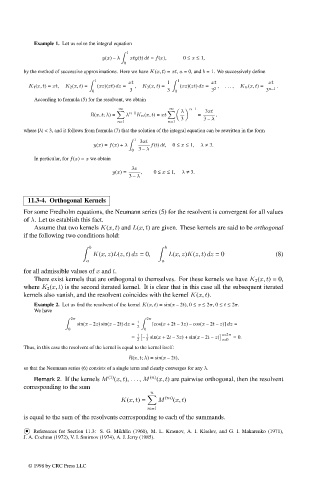Page 552 - Handbook Of Integral Equations
P. 552
Example 1. Let us solve the integral equation
1
y(x) – λ xty(t) dt = f(x), 0 ≤ x ≤ 1,
0
by the method of successive approximations. Here we have K(x, t)= xt, a = 0, and b = 1. We successively define
1 xt 1 1 xt xt
K 1 (x, t)= xt, K 2 (x, t)= (xz)(zt) dz = , K 3 (x, t)= (xz)(zt) dz = , ... , K n(x, t)= .
3 3 3 2 3 n–1
0 0
According to formula (5) for the resolvent, we obtain
∞ ∞ n–1
λ 3xt
R(x, t; λ)= λ n–1 K n(x, t)= xt = ,
3 3 – λ
n=1 n=1
where |λ| < 3, and it follows from formula (7) that the solution of the integral equation can be rewritten in the form
1 3xt
y(x)= f(x)+ λ f(t) dt, 0 ≤ x ≤ 1, λ ≠ 3.
0 3 – λ
In particular, for f(x)= x we obtain
3x
y(x)= , 0 ≤ x ≤ 1, λ ≠ 3.
3 – λ
11.3-4. Orthogonal Kernels
For some Fredholm equations, the Neumann series (5) for the resolvent is convergent for all values
of λ. Let us establish this fact.
Assume that two kernels K(x, t) and L(x, t) are given. These kernels are said to be orthogonal
if the following two conditions hold:
b b
K(x, z)L(z, t) dz =0, L(x, z)K(z, t) dz = 0 (8)
a a
for all admissible values of x and t.
There exist kernels that are orthogonal to themselves. For these kernels we have K 2 (x, t) ≡ 0,
where K 2 (x, t) is the second iterated kernel. It is clear that in this case all the subsequent iterated
kernels also vanish, and the resolvent coincides with the kernel K(x, t).
Example 2. Let us find the resolvent of the kernel K(x, t) = sin(x – 2t), 0 ≤ x ≤ 2π,0 ≤ t ≤ 2π.
We have
2π 2π
sin(x – 2z) sin(z – 2t) dz = 1 [cos(x +2t – 3z) – cos(x – 2t – z)] dz =
0 2 0
1
= 1 – sin(x +2t – 3z) + sin(x – 2t – z) z=2π =0.
2 3 z=0
Thus, in this case the resolvent of the kernel is equal to the kernel itself:
R(x, t; λ) ≡ sin(x – 2t),
so that the Neumann series (6) consists of a single term and clearly converges for any λ.
(1)
Remark 2. If the kernels M (x, t), ... , M (n) (x, t) are pairwise orthogonal, then the resolvent
corresponding to the sum
n
K(x, t)= M (m) (x, t)
m=1
is equal to the sum of the resolvents corresponding to each of the summands.
•
References for Section 11.3: S. G. Mikhlin (1960), M. L. Krasnov, A. I. Kiselev, and G. I. Makarenko (1971),
J. A. Cochran (1972), V. I. Smirnov (1974), A. J. Jerry (1985).
© 1998 by CRC Press LLC
© 1998 by CRC Press LLC
Page 535

